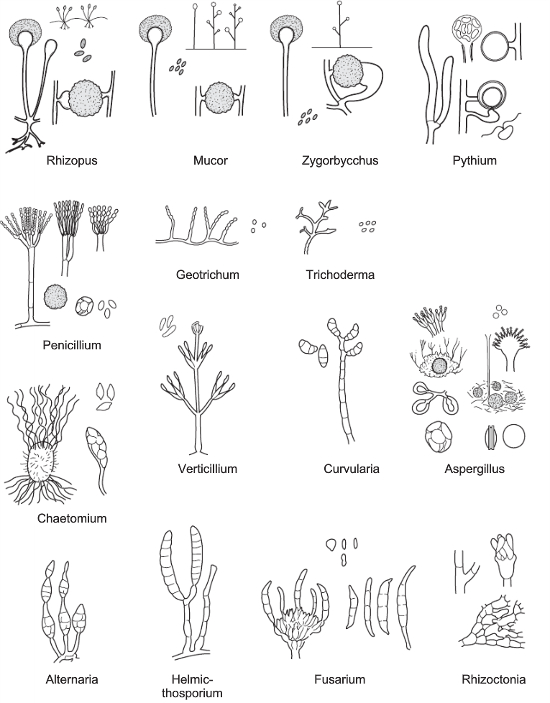Filamentous Fungi
Overview
Source: Laboratories of Dr. Ian Pepper and Dr. Charles Gerba - The University of Arizona
Demonstrating Author: Bradley Schmitz
Fungi are heterotrophic eukaryotic organisms, and with the exception of yeasts, are aerobic. They are abundant in surface soils and are important for their role in nutrient cycling and the decomposition of organic matter and organic contaminants. White rot fungi (phanerochaete chryosporium) for example, (Figure 1) are known to degrade aromatics.

Figure 1. White rot on birch.
Procedure
1. Soil Sample Preparation
- First, determine the initial moisture content of the soil by overnight drying of a known amount of the moist soil, and reweighing the dried soil. The equation to determine the initial moisture content of the soil is:

(Equation 1)
where:
MC = moisture content
W = net weight
D = dry weight - Calculate the amount of water that must be added to 25 g of soil to increase t
Results
Colony Counts
The number of fungal colonies per gram of soil is equal to the number of colonies counted on the plate multiplied by the reciprocal of the dilution plated. For example, if 46 colonies are counted at a dilution of 10-5, then the CFU per gram of soil is 46 x 105 or 4.6 x 106.
Identification of Three Different Fungal Genera
Fungi can be id
Application and Summary
Dilution and plating of soil fungi can be used as an indication of the health of a soil. Normally a “healthy” fertile soil will have 105 to 106 fungi per gram of soil. It can also be utilized to isolate pure cultures of specific fungi, subsequently evaluated for specific properties, such as the ability to degrade organic compounds. These can be detrimental as in the case of white rot fungi, or beneficial when toxic organics are degraded through biodegradation. Other uses of pure cultures
References
- Pepper, I.L., Gerba, C.P., Brusseau, M. Environmental & Pollution Science, 2nd Ed. Academic Press, San Diego, CA. (2006).
- Pepper, I.L., Gerba, C.P. Environmental Microbiology, A Laboratory Manual, 2nd Ed. Academic Press, Boston, MA. (2005).
Tags
Skip to...
Videos from this collection:

Now Playing
Filamentous Fungi
Environmental Microbiology
57.3K Views

Determination of Moisture Content in Soil
Environmental Microbiology
359.2K Views

Aseptic Technique in Environmental Science
Environmental Microbiology
126.4K Views

Gram Staining of Bacteria from Environmental Sources
Environmental Microbiology
100.2K Views

Visualizing Soil Microorganisms via the Contact Slide Assay and Microscopy
Environmental Microbiology
42.2K Views

Community DNA Extraction from Bacterial Colonies
Environmental Microbiology
28.8K Views

Detecting Environmental Microorganisms with the Polymerase Chain Reaction and Gel Electrophoresis
Environmental Microbiology
44.5K Views

RNA Analysis of Environmental Samples Using RT-PCR
Environmental Microbiology
40.4K Views

Quantifying Environmental Microorganisms and Viruses Using qPCR
Environmental Microbiology
47.8K Views

Water Quality Analysis via Indicator Organisms
Environmental Microbiology
29.5K Views

Isolation of Fecal Bacteria from Water Samples by Filtration
Environmental Microbiology
39.3K Views

Detection of Bacteriophages in Environmental Samples
Environmental Microbiology
40.7K Views

Culturing and Enumerating Bacteria from Soil Samples
Environmental Microbiology
184.2K Views

Bacterial Growth Curve Analysis and its Environmental Applications
Environmental Microbiology
295.9K Views

Algae Enumeration via Culturable Methodology
Environmental Microbiology
13.8K Views
Copyright © 2025 MyJoVE Corporation. All rights reserved
